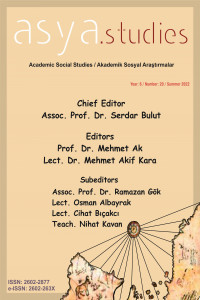FİNANSAL SÖMÜRÜ: ÖLÇEK UYARLAMA ÇALIŞMASI
Son yılllarda yapılan araştırmalar, yetişkinlerin finansal sömürüsünün büyük bir sorun haline geldiğini göstermiştir. Çoğunlukla, bu araştırmalar güvenin kötüye kullanılması, zorlama ve mali yetersizlik hakkında toplanan veriler ile değerlendirilmiştir. Aldatma, korkutma ve tehditler dâhil olmak üzere psikolojik istismar, her zaman finansal sömürüye neden olan faktörler arasında gösterilmektedir. Çalışmada, yabancı dilde ortaya konulmuş olan finansal sömürü ölçeğinin Türkçeye çevrilerek geçerlik ve güvenirliğinin test edilmesi hedeflenmiştir. Bireylerin finansal sömürü düzeyini ölçen ulusal yazında geçerlik ve güvenirliği kanıtlanmış bir ölçme aracı bulunmaması nedeniyle bu araştırmanın literatüre katkı sağlayacağı düşünülmektedir. İngilizceye çevirisi yapılan finansal sömürü nihai ölçeği, Gümüşhane’nin Köse ilçesinde yaşayan ve çiftçilikle geçimini sağlayan 18 yaş üstü 126 bireye uygulanmıştır. Yapılan analiz sounucunda orijinalinde 12 soru ve 5 boyuttan oluşan ölçek 10 soru ve 3 boyut olarak Türkçeye uyarlanmıştır. Doğrulayıcı faktör analizi neticesinde ölçeğin uyum iyiliği değerleri; x2/sd= 2,98, GFI= 0,886, AGFI= 0,809, CFI= 0,825, RMSEA= 0,08, SRMR= 0,067 şeklinde bulunmuştur. Kabul edilebilir seviyede sonuçlar elde edilmiş olup uyum iyiği değerleri elde edilen sonuçların makul seviyede ve mükemmel uyum ölçütleri aralığında olduğunu göstermektedir. Hesaplamalar sonucu ölçek iç tutarlılık katsayısı (güvenilirlik katsayısı) da ölçeğin kabul edilebilir seviyede olduğunu göstermektedir (α=0,79). Tüm bu bulgular ışığında İngilizce geliştirilmiş olan “Finansal Sömürü Ölçeği”nin ülkemizde de geçerli ve güvenilir bir ölçek olduğu değerlendirilmektedir.
Anahtar Kelimeler:
Finans, Finansal Sömürü, Finansal Açıklık
FINANCIAL EXPLOITATION: ADAPTATION TO SCALE
Recent studies have shown that the financial exploitation of adults has become a major problem. For the most part, these studies have been evaluated with data collected on abuse of trust, coercion, and financial inadequacy. Psychological abuse, including cheating, intimidation and threats, is always shown among the factors that cause financial exploitation. In the study, it was aimed to test the validity and reliability of the financial exploitation scale, which was put forward in a foreign language, into Turkish. It is thought that this research will contribute to the literature since there is no measurement tool with proven validity and reliability in the national literature measuring the level of financial exploitation of individuals. The final scale of financial exploitation, which was translated into English, was applied to 126 individuals over the age of 18 who live in the Köse district of Gümüşhane and earn their living by farming. As a result of the analysis, the scale, which originally consisted of 12 questions and 5 dimensions, was adapted into Turkish as 10 questions and 3 dimensions. As a result of confirmatory factor analysis, the goodness of fit values of the scale; x2/sd= 2.98, GFI= 0.886, AGFI= 0.809, CFI= 0.825, RMSEA= 0.08, SRMR= 0.067. Acceptable results were obtained, and the goodness-of-fit values show that the results obtained are at a reasonable level and in the range of perfect fit criteria. As a result of the calculations, the scale's internal consistency coefficient (reliability coefficient) also shows that the scale is at an acceptable level (α=0,79). In the light of all these findings, the “Financial Exploitation Scale” developed in English is considered to be a valid and reliable scale in our country as well.
Keywords:
Finance, Financial Exploitation, Financial Openness,
___
- Adli İstatistikler (2021). https://adlisicil.adalet.gov.tr/Resimler/SayfaDokuman/310520221416422021H%C4%B0ZMETE%C3%96ZELK%C4%B0TAP.pdf adresinden 14.09.2022 tarihinde erişildi.
- Alpar, R. (2016). Spor, Sağlık ve Eğitim Bilimlerinden Örneklerle Uygulamalı İstatistik ve Geçerlik-Güvenirlik. Ankara: Detay Yayıncılık.
- Amerika Federal Ticaret Komisyonu Verileri (2022). https://www.ftc.gov/news-events/news/press-releases/2022/02/new-data-shows-ftc-received-28-million-fraud-reports-consumers-2021-0 adresinden 22.02.2022 tarihinde erişildi.
- Bagshaw, D., Wendt, S., Zannettino, L. & Adam, V. (2013). Financial Abuse of Older People by Family Members: Views and Experiences of Older Australians and their Family Members. Australian Social Work, 66(1), 86-103.
- Consumer Financial Protection Bureau (2019). Suspicious Activity Reports on Elder Financial Exploitation: Issues and Trends. Washington, DC: CFPB).
- Garver, M. S. & Mentzer, J. T. (1999). Logistics Research Methods: Employing Structural Equation Modeling to Test for Construct Validity. Journal of Business Logistics, 20(1), 33-57.
- Gerbing, D. W. & Anderson, J. C. (1985). The Effects of Sampling Error and Model Characteristics on Parameter Estimation for Maximum Likelihood Confirmatory Factor Analysis. Multivariate Behavioral Research, 20(3), 255-271.
- Greene, A. J. (2022). M. D. Elder Financial Abuse and Electronic Financial Instruments: Present and Future Considerations for Financial Capacity Assessments. Am J of Geriatric Psychiatry, 30(1), 90−106.
- Karagöz Y. & Bardakçı, S. (2020). Bilimsel Araştırmalarda Kullanılan Ölçme Araçları ve Ölçek Geliştirme. Ankara: Nobel Akademik.
- Karagöz, Y. (2016). SPSS ve AMOS Uygulamalı İstatistiksel Analizler, (Güncellenmiş 2. Basım). Ankara: Nobel Yayınevi.
- Lacobucci, D. (2010). Structural Equations Modeling: Fit Indices, Sample Size, and Advanced Topics. Journal of Consumer Psychology, 20(1), 90-98.
- Lichtenberg, P. A., Tocco, M., Moray, J. & Hall, L. (2021). Examining the Validity of the Financial Exploitation Vulnerability Scale. Clinical Gerontologist, 44(5), 585-593.
- Phelan, A., Fealy, G. & Downes, C. (2017). Piloting the Older Adult Financial Exploitation Measure in Adult Safeguarding Services. Archives of Gerontology and Geriatrics, 70(2017), 148–154.
- Phelan, A., O’Donnell, D. & McCarthy, S. (2021). Financial Abuse of Older People by Third Parties in Banking Institutions: A Qualitative Exploration. Ageing & Society, 0(2021), 1–22.
- Wendt, S., Bagshaw, D., Zannettino, L. & Adams V. (2013). Financial Abuse of Older People: A Case Study. International Social Work, 0(0) 1–14.
- WHO/INPEA (2002). Missing Voices: Views of Older Persons an Elder Abuse. Geneva: World Health Organization.
- Wilson, J., Tilse, C., Setterlund, D. & Rosenman L. (2009). Older People and Their Assets: A Range of Roles and Issues for Social Workers. Australian Social Work, 62(2), 155–167.
- ISSN: 2602-2877
- Yayın Aralığı: Yılda 4 Sayı
- Başlangıç: 2017
- Yayıncı: Mehmet Akif KARA
Sayıdaki Diğer Makaleler
Okan KEKÜL, Kurtuluş Yılmaz GENÇ
FİNANSAL SÖMÜRÜ: ÖLÇEK UYARLAMA ÇALIŞMASI
ÖĞRETMENLERDE MAĞDURİYET VE KAYGI ARASINDAKİ İLİŞKİNİN İNCELENMESİ: HİLVAN ÖRNEĞİ
Eyyüp BİRLİK, Gökhan GENÇ, Cemal AZKIN
SİVİL TOPLUM KURULUŞLARININ KURUMLARA YÖNELİK İTİBAR ALGISINDA SÜRDÜRÜLEBİLİRLİK İLETİŞİMİNİN ROLÜ
HEDONİK FİYAT MODELİNE İLİŞKİN BİBLİYOMETRİK ANALİZ
TÜRKİYE’DE YABANCI SERMAYENİN TEŞVİK EDİLMESİNDE ABD ETKİSİ (1945-1955)
